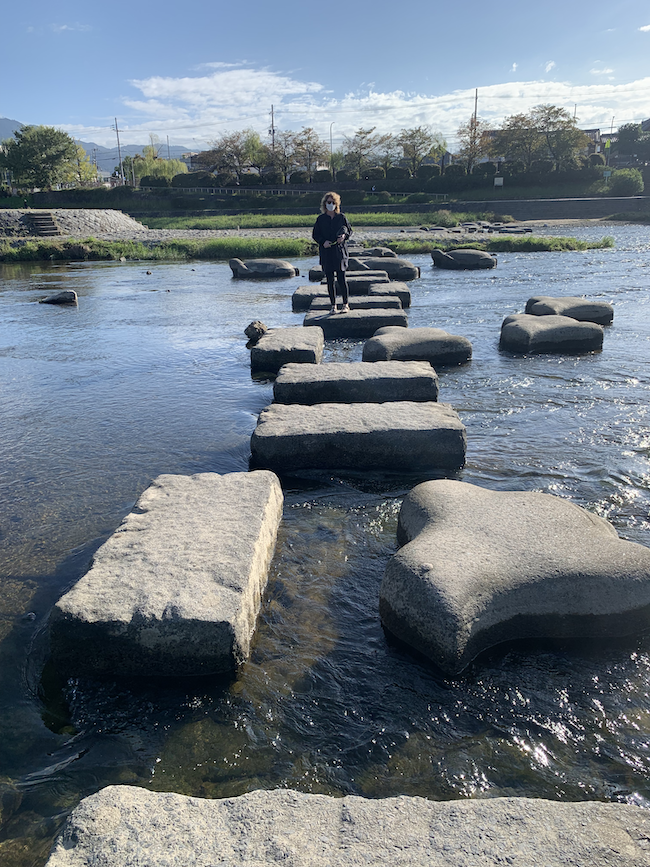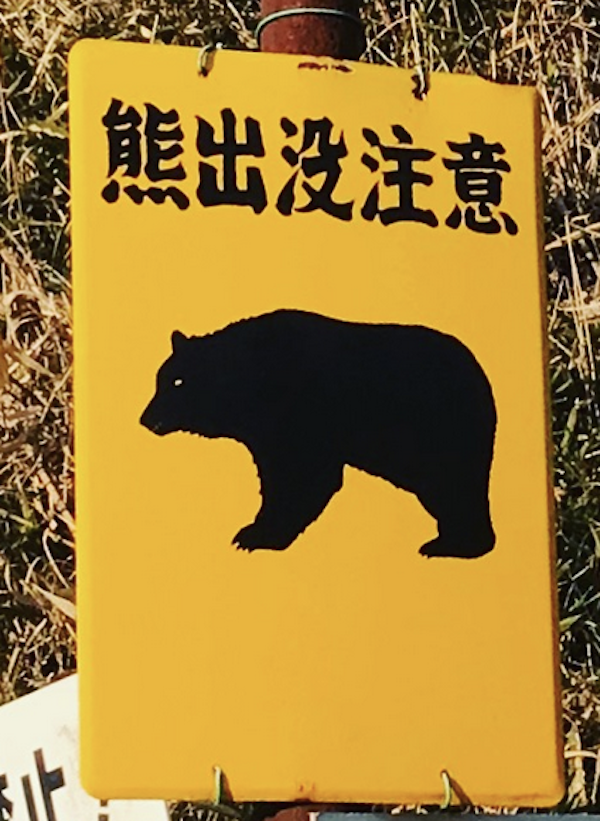Kyoto Report No. 2
This Tuesday report will provide some insights into life in Kyoto for a westerner in the age of Covid. Today, I report on stone fords across rivers, bears, monkeys, and more. All the before and after work action from Kyoto.
I run a lot in the mornings. I love running. I also love data. So the two come together on a daily basis.
The Kamo River near where I am living in Kyoto (in the University district) is a magnificent running resource.
The problem though, is that if you want to run 10 kms or 12 kms say, then the access points at bridges (typically but not exclusively) to the river are in discrete units of distance (there is either a bridge or not) and those units may not correspond to where I have to turn to get back home after heading north or south along the river to meet my distance goal for that particular run.
Solution: These stepping stone fords, which are strategically placed in between the main road bridges across the river and provide a little more continuity in distance measurement.
They are also fun to cross – the gaps between the stones are not all that close so you have to jump.
After rain, the river rises in height and flows very quickly and the stones become a sort of dare test course with water lapping over the tops.
Anyway, I use these fords a lot.
Foreign visitors to Australia often express some anxiety about the spiders and snakes that roam free there – well, roam free is a bit of an overstatement but they are there and no-one who knows really feels threatened by them.
While walking in the mountains to the East of Kyoto – last weekend, we were confronted with signs warning us about the aggressive monkeys that live around where we were.
What does an aggressive pack of monkeys do I wondered.
The sign, however, had the effect of stopping our journey up these steep steps to a cave, that was the shrine for some ‘kami’ or another.
Then after work last Thursday, we took off on our bikes to ride another mountain road (there was a little light left) and we came across another sign as follows:
Who would have thought?
It is a warning to beware of the bears that apparently hang out in that location.
We decided not to hang around.
Apparently, they are Asian black bears and usually run away when they see humans. Usually, of-course, is not always.
We also had just been to the bakery near the University and I had a lovely baguette sticking out of the basket on the front of my bicycle, which might have tempted some roaming bear to see us as food.
I really want o go back there though because there are old castle ruins in the forest near to that point.
So maybe all my running training will help if a bear lobs up while walking the forest trail to the ruins.
Speaking of which or not, one noticable thing about daily life in Japan is the locals seem to like packaging.
Plastic packaging.
For some time, I have been trying to work towards living without packaging and plastic for obvious reasons. That pursuit is hard in Australia but we have managed to reduce the amount we consume by a substantial margin.
Enter Japan.
There is packaging everywhere and in everything and often a product has multiple layers of plastic packaging from the outside bag to inside satchels to even more micro packages over individual items inside the inside satchels.
The current award for excessive packaging goes to the cheese cubes we saw in the supermarket the other day.
Now, first, I like cheese and as a vegetarian, cheese is an important part of my diet.
The Japanese do not eat much cheese and it is hard to get any vintage or tasty type hard cheeses in the standard supermarket.
So you can imagine my joy when I found what looked liked cheese cubes in the refrigeration area.
Upon closer inspection I saw that the plastic bag holding the cheese cubes was not the extent of the packaging.
Inside, each individual 2cm square cheese cube was individually and delightfully wrapped up in – you guessed it – a plastic bag. Stacks of these little packages within the main package.
If we are to save the planet, the Japanese will have to get over the seemingly boundless plastic packaging.
Anyway, having fun here!
That is enough for today!
(c) Copyright 2022 William Mitchell. All Rights Reserved.


Have fun.
I’m sorry to report that excessive packaging is also a feature of modern Chinese life, with only very moderate attempts by the leadership to change habits of retailers and consumers. Interesting bear warning sign: it makes sense in Chinese though 熊出 (bears out) is a little strange. No wonder my Japanese colleagues in China were quick to learn Chinese.
I have the same feeling. Japan has over-packaging culture. They are also too sensitive to food freshness that is why there is massive food waste. I think this culture should be changed.
When you live in Kyoto, you should enjoy Kyoto vegetables (京野菜). I think there are many good Shojin-ryori (mainly using vegetables, no meat, no fish) restaurant in Kyoto. Can I ask until when you will be in Kyoto? I want to take MMT lecture from you in Japan if possible!
running and (climate change) data.
I love running too.
funnily enough the creek ford stones (very large cut stones ~1 m³ in volume) where I run regularly were washed away in the floods last week. so no crossing for me as the water is running very hard and fast still. Sailors Creek, Hepburn Springs.
the 2 meter flood markers the next ford downstream (for cars) were flatten in the force of the water. debris indicates it got 2m above the level seen in the photo.
picture: https://www.icloud.com/iclouddrive/0547ozsxZwhFKTNplimVy9OCQ#sailors_creek,_hepburn_springs_-_1
flooding 6 km upstream the night before:
https://www.youtube.com/watch?v=A-I0WIfgyGI
three thinks Japan could do better on:
• get the MSG out of some much of the processed food ingredients – esp the ones they export!
• over packaging, but as a designer I’ve always had admiration in the aesthetic concern Japanese culture has in appreciation of ‘commodity goods’.
• putting bonito (dried then grated tuna flakes) in so much of their packaged food ingredients making them un-vegan and ocean-unfriendly.
otherwise it’s one of the few counties I’d like to visit that I’ve never been to. because.simply.amazing.
Hi Bill,
Japanese black bears are notorious for being very ornery-try not to get close to them. A bear bell while running might be a good idea. Having said that I never saw one and have walked extensively through the hills in east Kyoto. Aggressive monkeys bite, but usually ignore you if you ignore them-don’t smile (show your teeth), make eye contact, or point cameras at them.
If you’re after a challenge, Tanuki Dani has 250 stairs leading up to the temple and then a great path up to the hills. That should get your pulse rate up.
Re packaging in Japan, this is an interesting (if little dated) book in that respect:
Hendry, J. (1995). Wrapping Culture: Politeness, Presentation, and Power in Japan and Other Societies. Clarendon Press.
Packaging there is so culturally ingrained that any change will be very very difficult to overcome methinks.
Its a beautiful time of year over there. Enjoy!